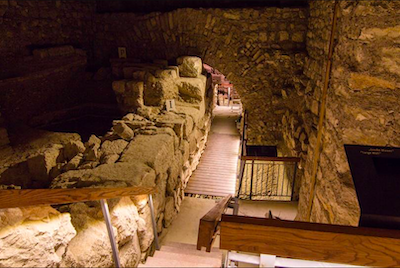Two-thousand years of biblical history lay buried 14 meters beneath the Lutheran Church of the Redeemer in Jerusalem.
By Dieter Vieweger
German Protestant Institute of Archaeology Jerusalem and Amman
University of Wuppertal
Biblical Archaeological Institute
February 2013
The church of the Redeemer was consecrated on Reformation Day 1898 by the German Kaiser Wilhelm II. The German Protestant Institute of Archaeology carried out an excavation in the Church of the Redeemer from 1970 to 1974. At its deepest point, this reached a layer of worked rock at 14m below the present concrete floor of the church. This was part of a huge quarry that was used for the construction of the Old Testament city in the south, and later, when the city was expanded by Herod the Great, lay directly to the east of the later church. The stone material was acquired outside the city walls, as was common in those days. This created a dry moat that additionally protected the city. The new town probably built by Herod the Great enclosed an area north of the present David Street until the north wall of the ancient Temple area. The quarry area appears to have also contained soft, and as such useless rock material that was not quarried – this made the hill of Golgotha. Later, tombs were dug at the edges of the quarry. When the quarry was no longer needed after the reign of Herod the Great, layers of silt were washed into the quarry, and gardens emerged.
Three layers of the earth that show evidence of agriculture and a garden wall have been discovered under the Church of the Redeemer. For this reason, Josephus Flavius named the nearby northern gate of Jerusalem Gennath Gate, or "Garden Gate". The city of Jerusalem in Jesus' time did not include the current site of the Holy Sepulchre and the Church of the Redeemer. Jesus final journey – the Via Dolorosa –therefore also did not lead along the route shown today, but from Herod's former palace – where Pontius Pilate also resided on high Jewish holidays – through the “Garden Gate” to Golgotha. Jerusalem received another northern wall in the forties, roughly where the northern city wall stands today. This city was besieged by Titus in 70 AD after the anti-Roman revolt. It was captured and later intensively destroyed. For 60 years Jerusalem lay in ruins. Emperor Hadrian had the former quarry site extensively filled in in 135 AD. Here – in the midst of his new city of Aelia Capitolina – some buildings emerged, built near the imposing new sanctuary that was probably dedicated to Aphrodite. On the former Temple Mount the Roman god Zeus was now worshiped. The city of Hadrian was home to the Xth Legion Fretensis. It was not walled. Emperor Constantine decided after the first Ecumenical Council in Nicaea in 325 to build a massive church in place of the temple of Aphrodite – the Church of the Holy Sepulchre.

Under the Church of the Redeemer the remains of a cobbled street and the south wall of the forum – the marketplace – which was located south of the Church of the Holy Sepulchre were found. The Church of the Holy Sepulchre had a front yard toward the cardo, the main road, a five-aisled church hall and behind that an enclosed courtyard. Finally, a dome was built over the site taken to be the grave of Jesus. The Church of the Holy Sepulchre was destroyed in 1009 by order of the Fatimid caliph Al-Hakim. The rock-cut holy tomb, which at that time was still intact, was also destroyed. The result was the First Crusade. The Crusaders rebuilt the church in a new form. To the south of the Church of the Holy Sepulchre, the church of St. Maria Latina was established. Parts of the old mosaic floor still exist under the Church of the Redeemer. The present church stands exactly on the medieval layout – but elevated by 2.10m. The Crusader period saw two more churches erected in the Muristan. St. John's Church and the Church of the Redeemer.
The archaeological park “Durch die Zeiten” under the Church of the Redeemer offers the possibility to do a journey through Jerusalem’s history, especially through the northern extension by Herod the Great; a Herodian quarry, garden and fields from the time of Jesus (at that time outside of the city walls); the debris from the destruction of the city by Titus (70 AD); buildings from the new City of Hadrian (132-135 AD); walls from a forum of Constantine and a marketplace southern of the Church of the Holy Sepulchre, a mosaic floor of the crusaders Church St. Maria Latina (12 century AD). By using 3D animations and lighting effects, more than 2.000 years of history is presented tangible and understandable.
You can also visit our museum with more information and exhibits in the courtyard of the church. Opening hours: Monday - Saturday: 9 - 12 am, 1 – 3.30 pm. For more information: www.erlöserkirche-jerusalem.info
